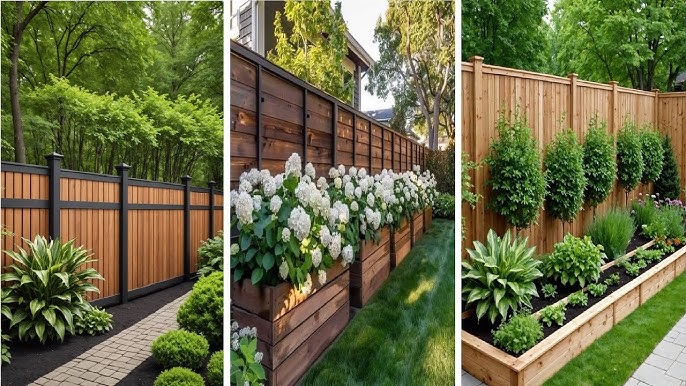Creating a private sanctuary in your garden requires careful consideration of fencing options that balance functionality, aesthetics, and durability. Privacy fences serve as essential barriers that define property boundaries while providing the seclusion needed to enjoy outdoor spaces without unwanted visibility from neighbors or passersby. Whether you’re looking to shield a vegetable garden, create an intimate patio area, or simply establish clear property lines, selecting the right privacy fencing solution can transform your outdoor environment into a peaceful retreat.
Modern homeowners face numerous choices when selecting privacy fence for garden applications, from traditional wood options to contemporary metal alternatives. Each material offers distinct advantages in terms of maintenance requirements, longevity, and visual appeal. Understanding these differences enables property owners to make informed decisions that align with their specific needs, budget constraints, and long-term goals for their outdoor spaces.
Understanding Privacy Fencing Fundamentals
Privacy fencing differs significantly from decorative or boundary fencing in both design intent and construction requirements. These structures typically stand between six to eight feet tall, providing adequate screening from ground-level visibility while maintaining structural integrity against wind loads and weather conditions. The primary function extends beyond simple boundary marking to include noise reduction, wind protection, and visual screening for enhanced outdoor privacy.
Effective fence for garden applications must consider several critical factors including soil conditions, local climate patterns, and maintenance accessibility. Gardens often present unique challenges due to irrigation systems, plant root systems, and seasonal ground movement that can affect fence stability over time. Professional installation becomes particularly important in garden settings where proper drainage and root barrier considerations prevent future structural issues.
The investment in quality privacy fencing pays dividends through increased property values, enhanced outdoor living experiences, and reduced maintenance requirements over the fence’s lifespan. Modern privacy fencing options incorporate advanced materials and construction techniques that provide superior weather resistance and longevity compared to traditional alternatives, making them cost-effective solutions for long-term garden privacy needs.
Wood Privacy Fencing Options
Traditional wood fencing remains among the most popular choices for garden privacy applications due to its natural appearance and versatile design possibilities. Cedar and redwood represent premium wood options that offer natural resistance to insects, decay, and weather damage while maintaining attractive grain patterns that complement garden environments. These materials require minimal chemical treatment while providing decades of reliable service when properly maintained.
Western Red Cedar Privacy Fence Panels exemplify the quality and durability available in modern wood fencing solutions. Cedar’s natural oils provide inherent protection against moisture and insects, making it an ideal choice for garden environments where irrigation and natural precipitation create challenging conditions for fence materials. The warm, natural tones of cedar complement virtually any garden design while aging gracefully to an attractive silver-gray patina.
Pine and fir options provide budget-conscious alternatives for homeowners seeking wood privacy fencing without premium material costs. These materials require regular maintenance including staining or painting to prevent moisture damage and extend service life. Pressure-treated lumber offers enhanced durability through chemical preservation processes that resist rot and insect damage, though some gardeners prefer untreated materials to avoid potential chemical leaching near edible plants.
Metal Privacy Fencing Solutions
Metal privacy fencing has gained considerable popularity among homeowners seeking low-maintenance, durable solutions for garden privacy needs. Corrugated metal fence provides excellent privacy coverage while offering superior weather resistance and longevity compared to traditional materials. Modern metal fencing incorporates advanced coating technologies that prevent rust and corrosion while maintaining attractive appearances for decades with minimal maintenance requirements.
Aluminum privacy fencing represents the premium end of metal fencing solutions, offering lightweight installation characteristics combined with exceptional corrosion resistance. Black aluminum privacy fences demonstrate how contemporary metal fencing can provide both functional privacy and attractive aesthetics suitable for sophisticated garden designs. These panels resist warping, cracking, and color fading while requiring only occasional cleaning to maintain their appearance.
Steel privacy fencing provides maximum security and durability for garden applications requiring robust protection against weather extremes and potential damage from large animals or falling debris. Powder coating technologies enable steel fencing to resist rust and corrosion while offering extensive color options that complement various garden styles and landscape designs.
Composite and Synthetic Privacy Fencing
Modern composite materials combine recycled wood fibers with synthetic polymers to create privacy fencing that mimics natural wood appearance while eliminating traditional maintenance requirements. These materials resist moisture damage, insect infestation, and color fading while maintaining consistent appearance throughout their service life. Composite fencing particularly appeals to environmentally conscious homeowners seeking sustainable alternatives to traditional materials.
Vinyl fencing collections offer comprehensive privacy solutions that eliminate painting, staining, and regular maintenance requirements associated with traditional materials. High-quality vinyl fencing resists cracking, warping, and color degradation while providing consistent privacy coverage that maintains its appearance for decades. Installation systems designed for homeowner accessibility make vinyl fencing attractive for DIY garden projects.
Synthetic materials excel in challenging garden environments where moisture, soil contact, and temperature fluctuations cause premature failure in traditional materials. These products often include warranties spanning twenty years or more, providing long-term value despite higher initial costs compared to basic wood alternatives.
Specialized Garden Privacy Fencing
Unique garden requirements often necessitate specialized fencing solutions that address specific challenges while providing desired privacy levels. Hog wire fence panels combined with privacy screening materials create attractive solutions for vegetable gardens where air circulation remains important while blocking visual access. These systems allow for seasonal modification of privacy levels through removable screening materials.
Living privacy fences incorporate fast-growing plants or climbing vines supported by underlying fence structures to create natural privacy barriers that enhance garden aesthetics. These systems require several growing seasons to achieve full privacy coverage but provide ongoing environmental benefits including air purification, wildlife habitat, and seasonal visual interest through flowering or foliage changes.
Modular privacy fencing systems enable customization of privacy levels, heights, and configurations to address specific garden layouts and functional requirements. These systems often incorporate interchangeable panels that allow modification of fence characteristics without complete replacement, providing flexibility for evolving garden needs and landscape changes.
Installation Considerations for Garden Privacy Fencing
Proper installation forms the foundation of successful privacy fencing performance, particularly in garden environments where soil conditions, drainage patterns, and plant root systems present unique challenges. Professional fence installation ensures proper post spacing, adequate depth, and appropriate foundation materials that provide long-term stability against soil movement and weather stresses.
Garden fencing installations must consider irrigation system locations, underground utilities, and future landscaping plans that could affect fence accessibility or structural integrity. Post placement requires careful measurement to avoid interference with existing plant root systems while ensuring adequate structural support for fence panels against wind loads and soil pressure.
Drainage considerations become particularly critical in garden settings where irrigation runoff and natural precipitation patterns can create standing water conditions that compromise fence foundation stability. Proper grading and drainage solutions prevent water accumulation that leads to post movement, panel sagging, and premature material deterioration.
Maintenance Requirements and Longevity
Different privacy fencing materials require varying maintenance approaches that affect long-term ownership costs and time investments. Wood fencing typically requires annual inspection and periodic refinishing to maintain weather protection and appearance, while metal and synthetic alternatives may need only occasional cleaning and minor repairs throughout their service lives.
Climate conditions significantly influence maintenance requirements for all fencing materials, with extreme temperature fluctuations, high moisture levels, and intense UV exposure accelerating normal wear patterns. Understanding local weather patterns enables informed material selection and maintenance scheduling that maximizes fence performance and appearance retention over time.
Preventive maintenance practices including regular cleaning, prompt repair of minor damage, and seasonal inspections prevent small issues from developing into major problems requiring expensive repairs or premature replacement. Establishing routine maintenance schedules ensures consistent fence performance while protecting the investment value of privacy fencing installations.
Cost Considerations and Budget Planning
Privacy fencing represents a significant investment that requires careful budget planning considering both initial installation costs and long-term ownership expenses. Material costs vary dramatically between basic wood options and premium synthetic alternatives, with installation complexity and site preparation requirements adding additional expense factors that affect total project costs.
Professional installation typically doubles the cost of DIY projects but provides warranty protection, proper installation techniques, and compliance with local building codes that protect property values and prevent future problems. Homeowner installation capabilities, available time, and tool access influence the practical feasibility of DIY approaches for different fencing materials and installation complexities.
Long-term cost analysis should include maintenance requirements, expected service life, and potential replacement costs when comparing different privacy fencing options. Higher initial investments in premium materials often provide superior long-term value through reduced maintenance needs and extended service life compared to budget alternatives requiring frequent repairs or early replacement.
Choosing the Right Privacy Fence for Your Garden
Selecting optimal privacy fencing requires careful evaluation of specific garden characteristics, functional requirements, and aesthetic preferences that guide material and design decisions. Site assessment including soil conditions, drainage patterns, existing vegetation, and microclimate factors influences fence performance and determines appropriate installation approaches for different locations within garden areas.
Functional requirements including desired privacy levels, noise reduction needs, wind protection, and security considerations help narrow material choices and design specifications. Gardens used for entertaining require different privacy characteristics than vegetable gardens or meditation spaces, with fence selection reflecting intended use patterns and privacy expectations.
Integration with existing landscape elements including plant materials, hardscape features, and architectural elements ensures privacy fencing enhances rather than conflicts with overall garden design themes. Color coordination, material compatibility, and scale relationships contribute to cohesive outdoor environments that maximize both functional and aesthetic benefits of privacy fencing investments.
Privacy fencing selection ultimately depends on balancing functional requirements, aesthetic preferences, and budget constraints while considering long-term maintenance commitments and performance expectations. The ten privacy fencing options discussed provide comprehensive solutions for various garden applications, from traditional wood installations to contemporary metal and synthetic alternatives. By carefully evaluating site conditions, usage requirements, and maintenance capabilities, homeowners can select privacy fencing solutions that enhance garden enjoyment while providing lasting value and performance. Investment in quality materials and proper installation ensures privacy fences serve their intended purpose for decades while contributing to property value and outdoor living quality.





























